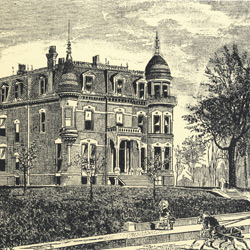Restoring a Home for Business

After working for others for nearly 20 years at a large Chicago advertising agency and two consumer product companies, Jane Converse thought she'd learned enough to set out on her own. In 1990, she did just that and started Converse Marketing, her own full-service marketing communications firm. Today, she works with her daughter, Amy Schlicksup, vice president; son, Ted, senior designer and web services director; and step-granddaughter, Allison West, office manager.
As the business outgrew its original 700-square-foot basement office, "the expanding need for space led us down a serendipitous path of historic preservation," recalls Converse. "In 1993, we purchased and renovated a 4,000-square-foot 1880s brownstone located at 504 Fayette Street in downtown Peoria. In 1998, when we outgrew that building, we purchased and renovated Easton Manor."
The 11,000-square-foot building, located at 1125 Main Street, was erected in 1880 and belonged to Edward S. Easton, one of Peoria's famed "whiskey barons." Its construction was quite a feat. At a time when most homes cost about $5,000 to build, the Victorian mansion cost $30,000, included building materials from countries across Europe, and took five construction crews just under a year to complete.
In 1901, Easton died, leaving his fortune to his wife, Sarah. When their son, Charles, challenged the will, Sarah was left with the manor, but very little money, and was forced to sell. A wealthy Peoria realtor lived in the home with his family for a while, before it was abandoned and left unoccupied for decades. In 1941, the building was finally sold, and it served as a funeral home for 40 years. Unfortunately, during this time, many of its remarkable features were sold or destroyed.
In the 1960s, a controversy grew about the demolition of Easton Manor. The Peoria City Council had given permission to build a new high-rise apartment complex at the location on three separate occasions, but these plans never came to fruition. In 1992, the manor was officially designated a Peoria landmark.
After its brief stint as a bed-and-breakfast, Converse purchased the building and worked with architect Leslie Kenyon and others to return it as closely as possible to its original state. "It just seemed to me that these wonderful old treasures shouldn't be destroyed," says Converse. "I've always had a love of history, and I feel responsible to people who have gone before...and making sure that history is not forgotten."
Preservation is important to Converse as a "business premise" as well. "People love to come here. They come for a meeting and say, ‘Golly, can we take a tour?' They want to see it, because it's such a very special Peoria building, and it really belongs to them as much as it belongs to me.
"I believe the privilege of occupying and giving purpose to these beautiful, old historic landmarks has inspired and motivated us all. This is an enchanting environment and great place to work." iBi

